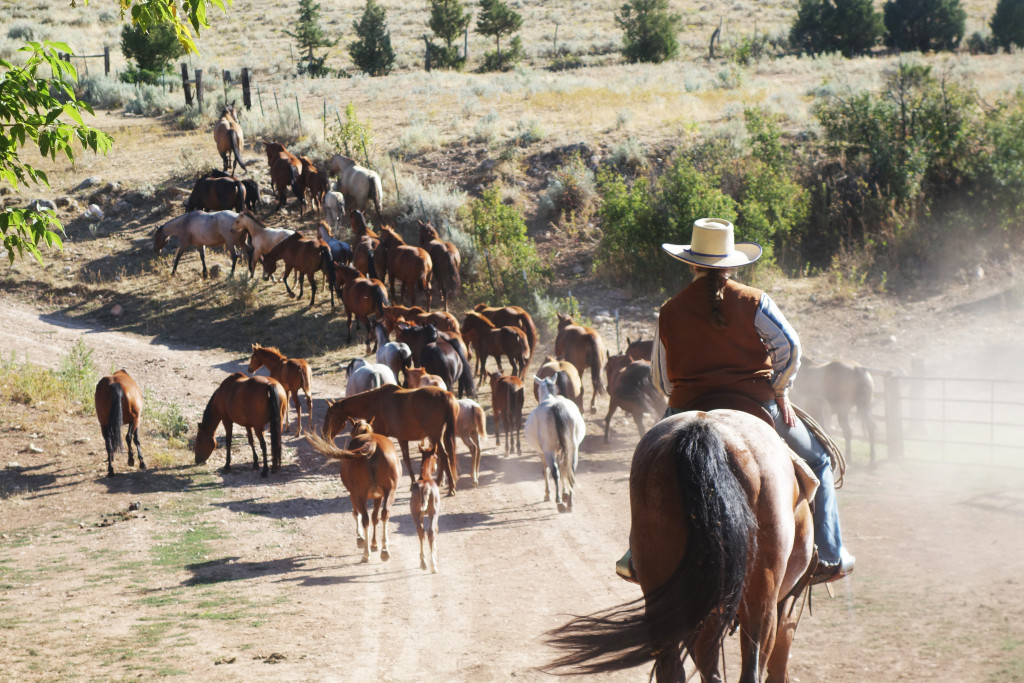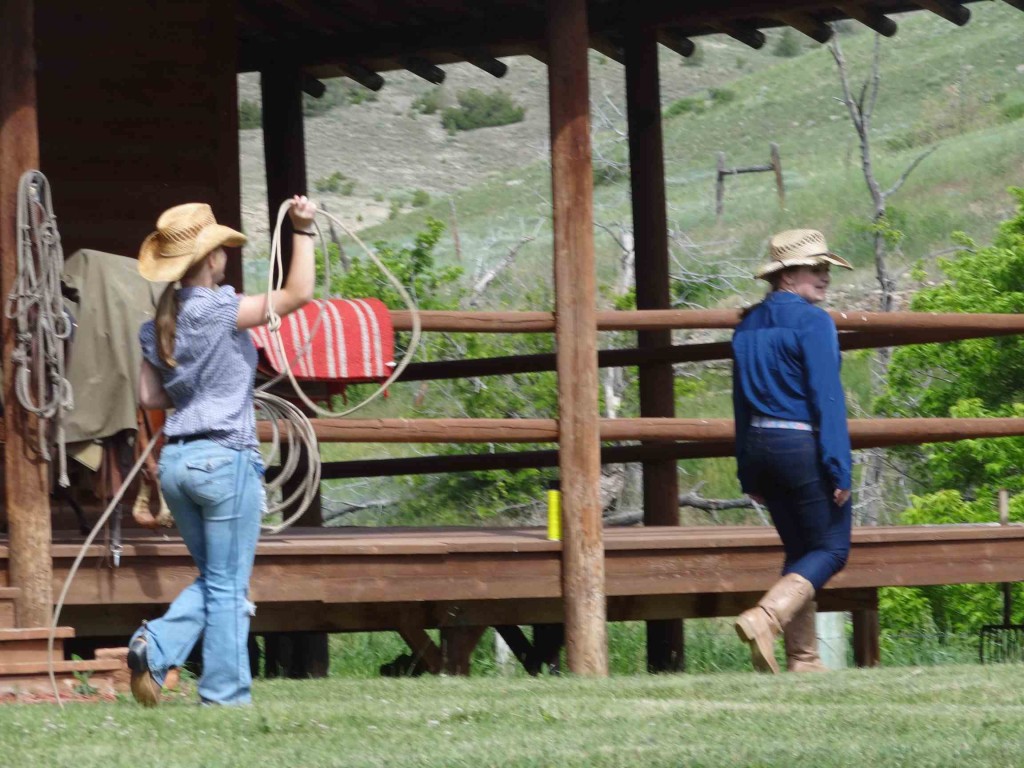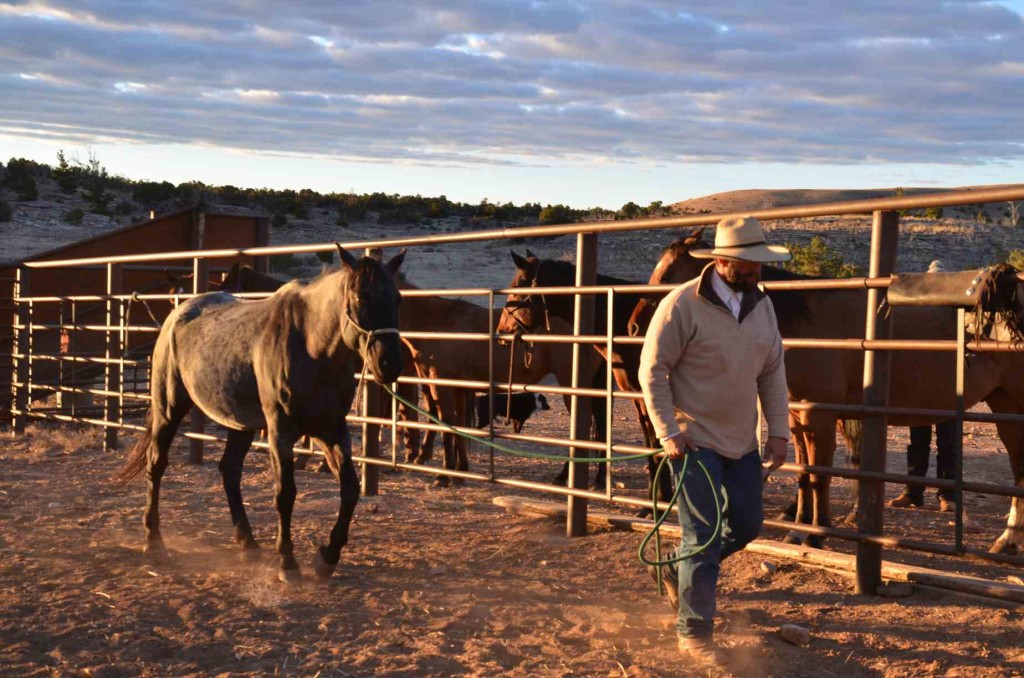
Preparing for Cattle Drive Vacations

At Dryhead Ranch, our cattle drive vacations begin long before we ever hit the trail. It’s hard to imagine the sort of preparation that goes into a successful drive if you’ve never done it before. On your cattle drive holiday, you will have a hands-on experience every step of the way.
This means gathering tack and handling grub, brushing horses and packing gear, and most importantly listening to expert instruction from our Trail Boss. The Trail Boss is your ultimate authority out on the range; his years of experience driving cattle and riding the West country insures you will be ready to tackle the sometimes tricky work of making cows go where you want to go.
Once everything is ready to go, you will likely get up before the break of dawn to start the ride into the range. Our horses are born and bred for this work. They love nothing more than taking their riders out to herd cattle. Just be prepared for a good long ride. There are more than 800 head of cattle out there and a lot of range to cover.
Once you reach the range, our Trail Boss will pair your with an experienced cowboy who will take one of many carefully-chosen positions around the herd. Driving cattle back to Dryhead Ranch can be a leisurely experience… even kids will have no trouble keeping up, and we make allowances for all skill levels. But don’t let that fool you. The first rule of the drive is “Keep your head up!”

This is because cows don’t always go where you want them to go. It is up to the trail boss, his team of cowboys, and our seasonal help (that means you!) to keep track of all the cattle until they reach the lush grazing lands at Dryhead ranch. Years of experience and keen instincts tell the trail boss and his cowboys where to drive the cattle, but only diligence and perseverance make sure the job gets done.
Along the line, our guests enjoy food from our chuck wagon and the incomparable experience of bonding over victories and challenges on the range with our seasoned staff. They help count and identify the cattle, using ear tags and brands to make sure Dryhead Ranch cows are coming home and everybody else isn’t. Most importantly, they learn valuable trade skills you can’t get anywhere else.
Driving cattle is hard work, but it is also deeply rewarding. There is nothing like hanging up your bridle at the end of a successful drive and settling in with a warm cup of coffee and a bunch of new friends to talk about what went great, what went bad, and what will happen next. This is the sort of thing you can only get on authentic cattle drive vacations with Dryhead Ranch.
We’d love you to come and give us a hand on our next drive. We love herding cattle, but we love sharing the excitement and reward of the ranch life even more!
Working Ranch Guide to Tack
Whether you are a veteran rider or just a beginner on your first cattle drive vacation, it pays to know the language of tack. Though you might not use every piece of equipment we mention in this article on your working ranch vacation, understanding the language of tack will help you be one step ahead of your game on your working cattle drive vacation.

Cattle Drive Vacation: Real Work
Anyone who has ever worked with their hands knows this: using the right tool makes all the difference. During a cattle drive holiday at Dryhead Ranch, you will learn all about the specialized gear that makes Montana cattle drives possible.
Saddles
Most people are familiar with the saddle. The saddle acts as a seat while horseback riding. It is typically made of leather and requires meticulous care to maintain, both for the comfort of the rider and the horse.
Surcingle
A surcingle is a strap that fastens around a horse’s girth region. It is used to hold the saddle in place.
Crupper
A “crupper” is occasionally used to add even more stability to the saddle. It is composed of a padded loop, usually leather, with one side attached to the saddle and the other around the base of the horse’s tail.
Breeching
Breeching, also known simply as a “horse harness,” is the series of straps used when a horse is used to pull a cart or other implement. Chances are, you will not see much breeching during your working ranch vacation.
Saddle Blanket
A saddle blanket is used between the horse’s back and the saddle to ensure the horse’s comfort during riding.
Stirrups
Stirrups are foot straps designed for added stability, especially during hard riding. They hang down from either side of the saddle.
Bridles
A bridle is a head harness used to direct the horse. Some people consider the entirety of the head gear, including the bit and the reins, as the “bridle.” Others might exclude the bit and reins, referring only to the harness.
Hackamores
Hackamores, or bitless bridles, are stiff nosebands used to direct horses. They are often used to train young horses and in Western riding.
Reins
The reins (depending on who you ask) attach to the bridle and are held in the rider’s hands. The rider uses the reins to direct the horse.
Bits
The bit is a piece of metal or other hard material held in the toothless region of a horse’s mouth by the headstall (unless you consider the bit and the headstall to be a part of the bridle, that is). It is used along with the reins to direct the horse.
Halters
Halters are bitless head harnesses which can accept a rope or lead for leading a horse while walking.
Horsing Around on a Working Cattle Ranch Vacation

Now that you know a little about tack, you can confidently talk equestrian with our seasoned staff during your working ranch vacation. Horses will be a big part of the adventure. They are an indispensable part of any cattle drive. Come learn a little more about horses with us here at Dryhead ranch. Book your cattle drive vacation today.
Authentic cattle drive vacations take place in the great outdoors. For those who are considering their first cattle drive retreat, there are few questions more important than this one: “What should I pack?”
Cattle Drive Gear Rules

Packing for an outdoor adventure is not the same thing as packing for a typical vacation. First of all, those shorts? You might want to leave them back at the house. Shorts and cowboy boots look sort of strange together, not to mention the way exposed lower legs tend to receive the brunt of the damage the range has to offer. Rocks, sand, sage brush, critters, horse and cow stuff… these are all things you should avoid making contact with. A nice well-worn pair of denim jeans seems to work well enough for us.
So, now that we have been over the shorts thing, let’s talk Gear Rules for your Montana cattle drive vacation.
Rule 1: Weight Is the Enemy
Cattle drives, just like any expeditionary outdoor adventure, involve moving from point “A” to point “B.” Now, this might seem like a simple-enough proposition, but the fact is this: every bit of weight a person takes out into the field means an extra bit of weight that person must carry around all the time. It might not seem like much, but added weight here and there really add up.
Rule 2: Use the Right Tools
Luckily for us, many manufacturers have designed outdoor gear in utilizing cutting-edge materials that are warm, light-weight, and packable. You might pay a premium for the latest synthetic-insulation mid layer, but when you’ve been out all day and you’re still comfortable, you’ll thank yourself.
Rule 3: Layers are Your Friend
Most outdoor gear systems are comprised of three layers: The base layer sits next to the skin. Its job is to regulate heat and moisture where you notice it the most. The mid layers are next; mid layers are usually specific to the needs of the task at hand. A nice fleece might be adequate for a crisp Spring ride; an 850-fill-power down jacket might be required for a winter foray. The shell layer forms the final layer of protection between you and the elements. Its job is to keep out rain and wind, especially if worn over a mid layer that doesn’t perform well when wet.
Rule 4: Pack It Up
A good day-pack carries your water, snacks, personal effects, and layers shed over the course of the day. A backpack with 22-30 liters of carrying capacity should work great for day-long adventures. A larger solution might be necessary for longer trips.
Cattle Drive Vacation Gear

Montana and Wyoming offer an excellent opportunity to try out all your outdoor gear in an environment sure to test your mettle. For more information about what to bring on your cattle drive vacation, give the folks down at Dryhead Ranch a call today. They are waiting to help you prepare for a vacation you will never forget.
Horse Anatomy
Without horses, we could never host cattle drive vacations. You couldn’t call cattle smart exactly, but they can be clever. More than that, they still possess the herd instincts of their wild auroch forebears. They can evade and confuse with the best of them, using herd dynamics to make life difficult for any creature trying to move them around. Man on foot is hopeless against cattle: not only are cattle fast when they need to be, but they are also dangerous if they want to be. It takes other herd animals and the guidance of a skilled team of riders to make the herd go where it needs to go. Horses fit the bill exactly.

Cattle Drive Horse Terminology
The equestrian world is full of specific terminology. Thanks to the fact that putting a leather saddle on a thousand-pound animal that walks on its tiptoes is a very specialized thing, horse people tend to use very specialized language. In the case of horses, it is especially important to know the anatomical terms we use for body parts people don’t have. For instance, do you know where your croup is? Can you identify your fetlock? If not, read on. We’ll start from the back and end with the withers.
Back
Where the saddle sits.
Barrel
The wide part of the horse formed by the ribs. Most of the organs are in here.
Buttock
The part of the hindquarters behind the thighs and in front of the dock.
Cannon
A very long hand or foot bone with the fetlock hoof at the end of it, though people sometimes call it a “shin.”
Chestnut
Not actually a nut, but rather one of (up to) four callous-like protrusion on the upper inner legs of a horse.
Chin Groove
Behind the lower lip and chin. The curb chain can go here.
Coupling
The loin.
Coronet
Sort of like your cuticle, this is where the outer surface of the hoof comes from.
Crest
The mane comes out here.
Croup
The tops of the hindquarters.
Dock
The part of the tail that isn’t just hair.
Elbow
The joint of the front leg where the leg meets the belly. Just like your elbow, but you have a longer humerus.
Ergot
Like a chestnut, but on the fetlock.
Face
Above the top lip, below the forehead.
Fetlock
Right above the hoof, a joint sort of like a joint at the end of your toe.
Flank
Where the barrel meets the hind legs.
Forearm
Somehow, on a horse, this is between the knee and the elbow.
Forehead
Where you might expect it to be, which is right in front of the poll.
Forelock
The part of the mane that falls on the forehead.
Frog
The soft back under-part of the hoof.
Gaskin
Like your calf muscle.
Girth
The part behind the elbow where you might strap on a saddle. Also the widest part of the barrel.
Hindquarters
Above the stifle, behind the barrel.
Hock
The big back leg joint, which is like your ankle.
Hoof
Like the foot of the horse, but more like finger- and toe tips with the world’s toughest nails.
Jugular Groove
Where the jugular vein goes.
Knee
The big bone in the front leg, which is like your wrist.
Loin
Right behind the saddle, from the last rib to the croup.
Mane
Long hair growing on the ridge of the neck.
Muzzle
Where the mouth and nostrils are.
Pastern
The bones between the hoof and the fetlock.
Poll
The joint at the beginning of the neck; also, the big bump on the top of the head.
Root of the Tail
Where the dock is attached to the rump.
Shoulder
Goes from the withers to the points of the shoulders.
Splints
Two skinny little bones on either side of all four cannon bones.
Stifle
Like your knee, if you had really short femurs and really long feet.
Tail
The long hairs coming out of the dock, and also (sometimes) the dock.
Throatlatch
Where the windpipe slips in under the jaw.
Withers
The tip tops of the spine bones between the shoulders.
Working Ranch Horse Getaway

So, now that your know how to talk about horses, it’s time to put that new knowledge to good use. Give us a call here at Dryhead Ranch today to talk about booking your own cattle drive horse vacation. We guarantee you’ll be able to brush up on your equestrian anatomical terminology while you’re here.
Interested in a Cattle Drive Vacation? Send us Your Questions or Comments.

